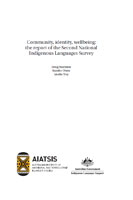Community, identity, wellbeing: The report of the Second National Indigenous Languages Survey
In 2007, National Geographic published a map of the top five language endangerment hotspots (Anderson and Harrison 2007) and tragically Australia is one of those five. In order to keep Australian languages strong, Aboriginal and Torres Strait Islander communities are engaging in numerous language activities, and governments are providing significant support.
The first ongoing national funding for Australian languages began in 1992. This national program has now grown to approximately $10 million annually for funding language activities, particularly at the community level, to create and support projects that ensure the continuation, revival and survival of Australian languages. Nationally, there is an increase in forums for those interested in Australian languages, for example, Puliima - the biennial National Indigenous Language and Technology Forum, dedicated sessions at the Australian Linguistic Society annual conference, mailing lists, websites and other local and international forums.
In this, the report of the Second National Indigenous Languages Survey (NILS2), we offer key insights for governments and communities into the current situation of Australian languages, how they are being supported and how best to continue this support. The survey paints a complex picture of the current state of health of Indigenous languages in Australia, but also show a growing recognition of their value as elements of identity and self-esteem.
AIATSIS Chair, Professor Mick Dodson, said the complicated picture produced by the results showed the continuing trend of increased language loss across the country.
“From the information collected we estimate there’s around 120 Indigenous languages still spoken today - a drop from 145 in 2005.”
“But at the same time, languages such as Wiradjuri from central western New South Wales are being revived and are now taught to children in local schools. This positive outcome clearly indicates the need for federal, state and territory governments to allocate funding for the development and delivery of programs to train language workers, interpreters and teachers.”
Respondents to the survey held an almost unanimous view that connecting with and learning about language has a powerfully beneficial effect on people’s well-being.
The survey, funded by the Ministry for the Arts, Attorney-General’s Department through the Indigenous Languages Support program, is the second such undertaking by the AIATSIS, who engaged with language organisations and individuals to garner information on two key areas - language activities and language attitudes.
